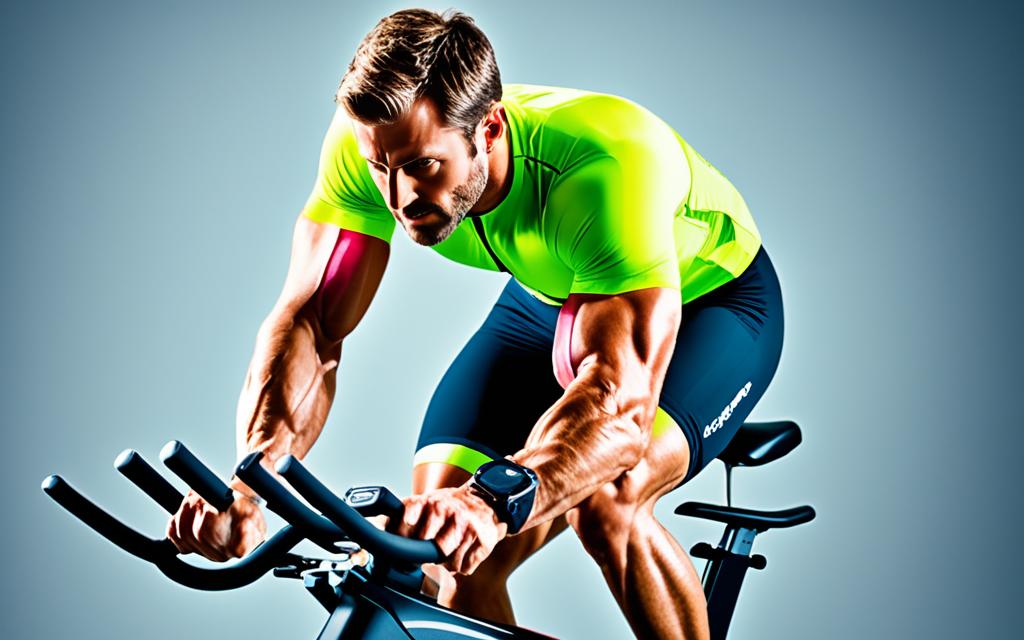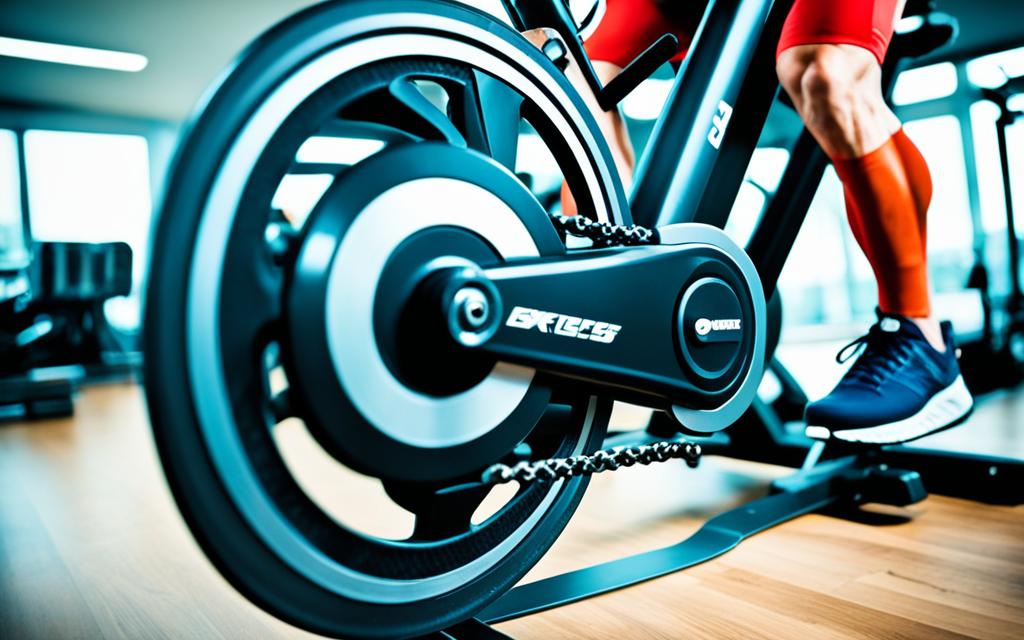Welcome to our comprehensive exercise bike Work muscles guide, where we will explore the key muscle groups targeted during your rides. Whether you’re a fitness enthusiast or looking for a convenient way to stay active at home, using an exercise bike can provide numerous benefits for your muscles.
When you hop on an exercise bike, you engage various muscle groups, including the lower body, core, and even the upper body to some extent. By understanding the specific areas that are worked, you can tailor your workouts and maximize the benefits.
Key Takeaways:
- Using an exercise bike targets multiple muscle groups in your body.
- The lower body, including the quadriceps, hamstrings, calves, and glutes, is extensively worked during cycling.
- Your core muscles, such as the rectus abdominis and obliques, are engaged to maintain stability and balance.
- The upper body, including the biceps, triceps, back, and shoulders, also experiences some level of activation.
- Regular exercise bike workouts can improve muscle strength, endurance, flexibility, and overall tone.
Cycling Muscles Targeted: Lower Body Workout
One of the primary benefits of using an exercise bike is its ability to provide an effective lower-body workout. The cycling motion engages multiple leg muscles, including the quadriceps, hamstrings, calves, and glutes. These muscles are responsible for pedaling, providing power, and stabilizing your body during your workout.
Riding an exercise bike not only helps you burn calories and improve cardiovascular fitness, but it also strengthens and tones your leg muscles. This makes it an excellent choice for those looking to build lower body strength or recover from leg injuries.
Let’s take a closer look at the leg muscles exercised during an exercise bike workout:
- The quadriceps are located at the front of your thighs and are responsible for extending your legs during the pedaling motion. These muscles, including the vastus lateralis, vastus medialis, vastus intermedius, and rectus femoris, work together to push the pedals down.
- The hamstrings are located at the back of your thighs and are responsible for flexing your legs during the pedaling motion. These muscles, including the biceps femoris, semitendinosus, and semimembranosus, work together to pull the pedals back up.
- The calves, including the gastrocnemius and soleus muscles, help push the pedals down and provide power during the cycling motion.
- The glutes are the muscles in your buttocks that help stabilize your hips and provide power during the pedal stroke. The gluteus maximus is the largest muscle in this group and plays a significant role in the cycling motion.
By targeting these leg muscles, an exercise bike workout can help you strengthen and tone your lower body, improve muscular endurance, and increase overall leg strength. Regular cycling sessions on an exercise bike can lead to improved athletic performance, better balance, and enhanced mobility.
Now that you understand the leg muscles involved in an exercise bike workout, let’s explore how cycling also engages your core muscles in the next section.
Engaging the Core Muscles
While cycling mainly targets the lower body, it also engages the core muscles to maintain stability and balance. Your abdominal muscles, including the rectus abdominis and obliques, are actively involved in keeping your body upright and maintaining proper form throughout your ride.
The constant motion of pedaling on an exercise bike requires core activation to stabilize your body and support your lower back. This engagement helps to improve core strength and endurance, contributing to better posture and overall stability.
By actively engaging your core muscles during your exercise bike workouts, you can enhance the effectiveness of your workout and maximize muscle engagement. Focus on maintaining a strong and stable core by bracing your abs and avoiding excessive leaning or hunching over the handlebars.
Here are a few tips to help you engage your core muscles effectively:
- Think about drawing your navel towards your spine to activate your deep core muscles.
- Keep your upper body relaxed and your shoulders down and back.
- Avoid excessive bouncing or rocking, as this can reduce core activation and strain your lower back.
- Focus on maintaining a neutral spine alignment throughout your ride.
By incorporating exercises that specifically target your core muscles, such as planks and bicycle crunches, into your overall fitness routine, you can further strengthen and tone your abdominal muscles.
| Muscles Engaged: | Core Muscles |
|---|---|
| Main Muscles | Rectus Abdominis, Obliques |
| Secondary Muscles | Transverse Abdominis, Erector Spinae |
| Tertiary Muscles | Internal and External Obliques |
Engaging your core muscles during your exercise bike workouts not only helps you achieve better balance and stability, but it also supports overall spinal health and improves your posture. So, next time you hop on your exercise bike, remember to activate your core and make the most out of your workout.
Upper Body Involvement: Biceps and Triceps
When it comes to working out on an exercise bike, the focus is often on the lower body. However, it’s important to note that you can also engage your upper body to some extent during your rides. While pedaling, you may experience activation in your biceps and triceps as they work in coordination with the movement of your legs.
As you pedal, your arms remain in a semi-flexed position, constantly engaging your biceps and triceps to stabilize and support your upper body. Although the intensity of their activation may not be as high as in dedicated upper body exercises, your biceps and triceps still contribute to the overall muscle engagement during your workout.
To maximize the involvement of your biceps and triceps while cycling, focus on maintaining a firm grip on the handlebars and applying gentle pressure. This technique will help target and activate these upper body muscle groups, providing a more well-rounded workout.
If you’re looking to specifically target your biceps and triceps, incorporating upper body exercises or weightlifting sessions alongside your exercise bike workouts can be beneficial. This combination allows you to achieve a comprehensive full-body workout that targets multiple muscle groups.
By engaging your upper body while utilizing an exercise bike, you can optimize your workout and enhance overall muscle engagement. The integration of biceps and triceps activation not only adds variation to your routine but also contributes to a more balanced and effective workout.
Muscles Activated |
Benefits |
|---|---|
| Biceps and Triceps | Enhances upper body strength and stability |
| Quadriceps, Hamstrings, Calves, and Glutes | Strengthens and tones the lower body |
| Abdominal muscles | Improves core strength and stability |
| Back and Shoulder Muscles | Promotes better posture and upper body support |
Remember, incorporating upper body engagement on an exercise bike is optional and may not be the primary goal of your workout. However, if you’re looking to diversify your routine or engage your upper body alongside your cardiovascular exercise, this can be an excellent way to achieve a more comprehensive workout.
Additional Muscle Engagement: Back and Shoulders
Riding an exercise bike not only provides an effective lower-body workout but also engages several key muscle groups in your upper body. While pedaling, you rely on the stabilization of your upper body, which activates the muscles in your back and shoulders.
Your back muscles play a crucial role in maintaining an upright posture throughout your ride. The erector spinal muscles, located along the length of your spine, work to support and extend your back. This engagement helps improve your overall posture and contributes to a stronger back.
Another important muscle group that is involved in riding an exercise bike is the latissimus dorsi, commonly known as the lats. These broad muscles, located on the sides of your back, are responsible for controlling movement in your arms and shoulders. As you grip the handlebars and maintain balance, your lats come into action to support your upper body.
In addition to the back muscles, your shoulder muscles also play a role in maintaining balance and stability during your workout. The deltoids, located on the outer side of your shoulders, are primarily responsible for lifting your arms and helping to stabilize the bike. The trapezius muscles, which extend from the back of your neck to your upper back, help with shoulder movement and overall stability.

By engaging your back and shoulder muscles while riding an exercise bike, you can improve overall upper body strength and stability. This can have a positive impact on your posture, as well as help prevent muscle imbalances and injuries.
Benefits of Exercise Bike Work for Muscles
Incorporating an exercise bike into your fitness routine offers numerous benefits for your muscles. Regular cycling on an exercise bike can help improve lower body muscle strength, endurance, and flexibility. It can also promote better posture, core stability, and overall muscle tone.
Lower Body Muscle Strength: Cycling on an exercise bike primarily targets the muscles in your lower body, such as the quadriceps, hamstrings, calves, and glutes. These muscles are responsible for generating power and driving the pedaling motion. Regular cycling can help strengthen and tone these muscle groups, improving their overall strength and endurance.
Endurance and Cardiovascular Health: Cycling is a great cardiovascular exercise that elevates your heart rate and improves lung capacity. Regular cycling on an exercise bike can help improve your cardiovascular fitness, allowing you to engage in longer workouts and physical activities without getting fatigued quickly.
Flexibility: The repetitive cycling motion on an exercise bike helps improve the flexibility of your lower body. The continuous movement stretches and loosens the muscles, reducing muscle stiffness and promoting a better range of motion.
Better Posture: Proper posture is essential during exercise to avoid strain or injury. Cycling on an exercise bike requires you to maintain an upright position and engage your core muscles for stability. Over time, this can help improve your posture and reduce the risk of back or neck pain.
Core Stability: While the primary focus of an exercise bike work is the lower body, it also engages your core muscles. Your abdominal muscles, including the rectus abdominis and obliques, are actively involved in maintaining proper form and stability during your cycling workouts.
Benefits of Exercise Bike Work for Muscles |
Explanation |
|---|---|
| Improved lower body muscle strength | Cycling targets the quadriceps, hamstrings, calves, and glutes, strengthening and toning these muscles. |
| Enhanced endurance and cardiovascular health | Regular cycling on an exercise bike improves cardiovascular fitness, increasing endurance. |
| Increased flexibility | The cycling motion on an exercise bike helps improve lower body flexibility and range of motion. |
| Better posture | Cycling on an exercise bike promotes proper posture and reduces the risk of back or neck pain. |
| Core stability | Engaging the abdominal muscles during cycling helps improve core stability and balance. |
Customizing Your Workout for Specific Muscle Groups
To maximize the effectiveness of your exercise bike workouts, it’s important to tailor your routine to target specific muscle groups. By adjusting the resistance and intensity levels on your exercise bike, you can create a workout that challenges and engages the muscles you want to focus on. Here are a few strategies to customize your workout and target specific muscle groups:
1. Increasing Resistance for Leg Muscle Work
One way to target your leg muscles is by increasing the resistance on your exercise bike work. This creates a greater challenge and forces your leg muscles to work harder. Focus on maintaining good form and pedal with a slower cadence to engage your quadriceps, hamstrings, calves, and glutes to a greater extent. Remember to listen to your body and gradually increase the resistance as your strength improves.
2. Engaging Different Muscle Fibers with Interval Training
Interval training involves alternating between periods of high-intensity effort and lower-intensity recovery. This type of workout can target different muscle fibers and help build endurance. Incorporate interval training into your exercise bike routine by pedaling at a faster pace or increasing the resistance for a set amount of time, followed by a period of active recovery where you decrease the intensity. This can effectively engage various muscle groups and promote muscle growth and cardiovascular fitness.
3. Incorporating Hill Climbs for a Full Lower Body Workout
Simulating hill climbs on your exercise bike work is an excellent way to target your leg muscles comprehensively. Increase the resistance gradually as you pedal, mimicking the experience of climbing a steep hill. This engages your quadriceps, hamstrings, calves, and glutes even more, providing a challenging lower-body workout. Incorporating hill climbs into your routine can help improve strength, endurance, and cardiovascular fitness.
To track your progress and ensure you are customizing your workout effectively, consider using the built-in features of your exercise bike such as workout programs, resistance levels, and heart rate monitors. By continually challenging yourself and targeting specific muscle groups, you can maximize the benefits of your exercise bike workouts and achieve your fitness goals.

| Muscle Group | Recommended Resistance Level | Intensity Level |
|---|---|---|
| Quadriceps | Medium-High | Moderate-High |
| Hamstrings | Medium-High | Moderate-High |
| Calves | Medium-High | Moderate-High |
| Glutes | Medium-High | Moderate-High |
Tips for Maximizing Muscle Engagement on an Exercise Bike
To optimize muscle engagement during your exercise bike workouts, it is important to maintain proper form and technique. By following these tips, you can make the most out of your workouts and target specific muscle groups effectively.
1. Focus on Pedaling Through the Heels
When cycling on an exercise bike, concentrate on pushing through your heels rather than solely relying on the balls of your feet. This technique helps to activate your calf muscles, hamstrings, and glutes more efficiently. It also reduces the strain on your knees and distributes the workload evenly across your leg muscles.
2. Engage Your Core Muscles
While pedaling, actively engage your core muscles by pulling your belly button towards your spine. This action stabilizes your body and increases the muscle engagement in your abdominals, including the rectus abdominis and obliques. Maintaining a strong core also improves your overall posture and prevents lower back discomfort.
3. Maintain an Upright Posture
Keep your back straight and shoulders relaxed throughout your ride. Avoid slouching or leaning excessively forward, as this can strain your neck and back muscles. By maintaining an upright posture, you’ll optimize the engagement of your back muscles, including the erector spine and latissimus dorsi, while also improving breathing efficiency.
4. Vary Your Workouts
To challenge your muscles and prevent plateaus, incorporate different training programs and resistance levels into your exercise bike workouts. Mix high-intensity interval training (HIIT) sessions with longer endurance rides to target different muscle fibers and enhance overall fitness. By constantly varying your workouts, you’ll continue to stimulate muscle growth and improve cardiovascular endurance.
5. Take Advantage of Training Programs
Most exercise bikes offer a variety of pre-programmed training options, such as hill climbs or interval workouts. These programs automatically adjust the resistance and speed, optimizing muscle engagement and simulating real-world cycling conditions. Experiment with different programs to keep your workouts challenging and enjoyable.
By following these tips, you can optimize muscle engagement on your exercise bike and achieve better results in your workouts. Remember to listen to your body and gradually increase the intensity and duration of your rides to avoid overexertion or injury.
| Muscle Groups | Benefits of Engagement |
|---|---|
| Leg muscles (quadriceps, hamstrings, calves, glutes) | Improved lower body strength, endurance, and muscle tone |
| Abdominal muscles (rectus abdominis, obliques) | Enhanced core stability and better posture |
| Back muscles (erector spinae, latissimus dorsi) | Improved postural strength and reduced back discomfort |
| Shoulder muscles (deltoids, trapezius) | Increased upper body stability and improved balance |
Conclusion
The exercise bike work is a versatile fitness equipment that offers a wide range of benefits for your muscles. By incorporating regular cycling into your workout routine, you can effectively improve lower body strength and engage various muscle groups. The cycling motion targets key areas such as the quadriceps, hamstrings, calves, and glutes, helping to strengthen and tone these muscle groups.
In addition to the lower body, the exercise bike work also engages your core muscles. Your abdominal muscles, including the rectus abdominis and obliques, play a crucial role in maintaining stability and balance. As you pedal, your upper body also gets involved to some extent, activating your biceps and triceps.
Riding an exercise bike work not only improves muscle strength and tone but also offers other benefits such as enhanced flexibility, better posture, and increased endurance. It’s a great way to customize your workouts and achieve your fitness goals by adjusting the resistance and intensity levels. With its flexibility and adjustability, an exercise bike provides an effective and enjoyable way to engage multiple muscle groups and maintain overall muscle health.
FAQ
What muscle groups do the exercise bike work?
The exercise bike primarily targets the lower body muscles, including the quadriceps, hamstrings, calves, and glutes. Additionally, it engages the core muscles, such as the abdominals, and to a lesser extent, the biceps, triceps, back muscles, and shoulder muscles.
How does the exercise bike work the leg muscles?
The pedaling motion of the exercise bike works the major leg muscles, including the quadriceps (front of the thigh), hamstrings (back of the thigh), calves (gastrocnemius and soleus), and glutes (buttocks). These muscles contract and relax during each pedal stroke, providing strength and endurance to the lower body.
What are the benefits of using an exercise bike work for muscles?
Using an exercise bike can help improve lower body muscle strength, endurance, and flexibility. It also engages the core muscles for stability and balance. Regular cycling on an exercise bike promotes better posture, overall muscle tone, and cardiovascular health.
Do exercise bikes engage the upper body muscles?
While the primary focus of an exercise bike is the lower body, some upper body muscles, such as the biceps and triceps, can be engaged to a certain extent. However, the level of engagement in the upper body is significantly lower compared to the lower body muscles.
Are there any additional muscle groups that are engaged while using an exercise bike?
Yes, riding an exercise bike requires the stabilization of the upper body, which engages the back muscles, including the erector spinae and latissimus dorsi. The shoulder muscles, such as the deltoids and trapezius, are also involved in maintaining balance and supporting the upper body during the workout.
How can I target specific muscle groups during my exercise bike workout?
To target specific muscle groups, you can adjust the resistance and intensity levels on your exercise bike. Increasing the resistance can provide a greater challenge for your leg muscles while incorporating interval training can help engage different muscle fibers and build endurance.
How can I maximize muscle engagement on an exercise bike?
To maximize muscle engagement during your exercise bike workouts, focus on maintaining proper form and technique. Pedal through the heels, engage your core muscles and maintain an upright posture throughout your ride. Vary your workouts by incorporating different training programs and resistance levels to continuously challenge your muscles.
What are some tips for customizing my exercise bike workout for specific muscle groups?
Customizing your exercise bike workout for specific muscle groups can be done by adjusting the resistance levels and incorporating interval training. Increase the resistance to target and challenge the leg muscles, and vary the intensity and duration of intervals to engage different muscle fibers and enhance overall muscle strength and endurance.
Is it important to maintain proper form and technique while using an exercise bike?
Yes, maintaining proper form and technique is crucial to optimize muscle engagement and prevent injury. Focus on pedaling through the heels, engage your core muscles, and keep an upright posture throughout your ride. Paying attention to form will ensure that you effectively target the intended muscle groups and get the most out of your workout.




